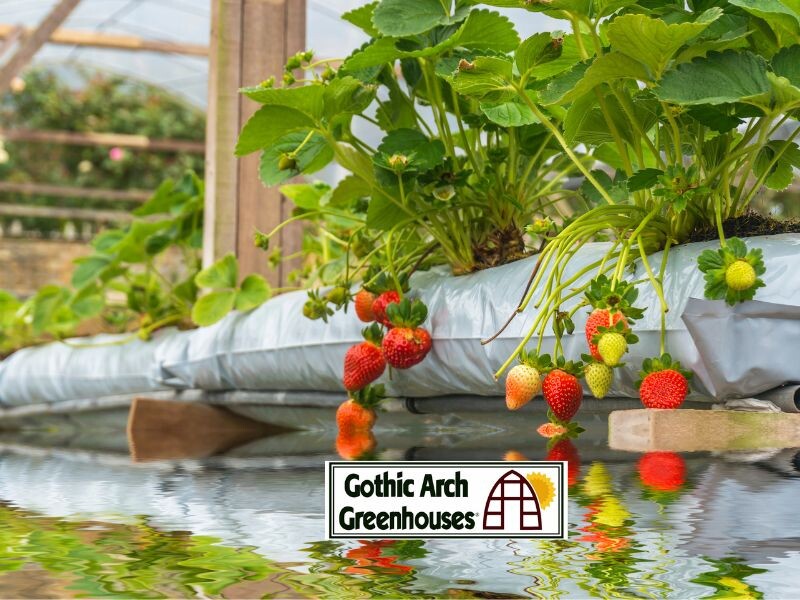
Recommended System:NFT stands for Nutrient Film Technique. Because of the way Nutrient Film Technique works, it’s perfect for growing hydroponic strawberries.
Growing Medium: expanded clay pellets, leca, heydite, or crushed shale rock
pH Level: for Strawberries maintained between 5.8 and 6.2
Nutrients: Maintaining a nutrient rich solution at a slightly higher EC (around 2.5) with good levels of potassium will help with sugar accumulation in the fruit.
Lighting Needed: seven hours of full sun per day or if growing hydroponic strawberries inside use fluorescent grow lights.
Temperature: Not to exceed 75 degrees Fahrenheit with a minimum temperature of 60 degrees Fahrenheit.
Humidity Level: Strawberries like to get wet, so they like higher humidity levels
Care Required: very demanding
Successful strawberry production can be easily done using hydroponics (the science of growing plants in soil-less material) in the controlled environment of a Gothic Arch Greenhouse…providing you with berries year-round…protected from birds and other animals. Growing berries with hydroponics can be challenging, yet rewarding as it can be adapted to almost any growing environment. The ideal environment to protect from weather would be inside a quality build Gothic Arch Greenhouse with the use of artificial lighting during the winter months.
(A)Choose the variety of berries you want to grow. The most populare are blackberries, strawberries, raspberries, blueberries, etc., with the best type of plants for hydroponic growing being the “day neutral” varieties.
(B)With a sterile grouing medium such as crushed shale or clay pellets, secure the bottom of a hydroponic mesh bin. Inquire about what type of liner you should get depending on the environment you are going to grow the berries in. The liner should be soaked for at least 30 minutes in pH-balanced water prior to planting.
(C)Now you’re ready to set the berry plant into the growing bin, with the roots spread out over the liner. After pouring the growing medium into the bin, make sure the berries are above the surface so it has enough light and fresh air to thrive. The plant might rot, if is submerged in water.
(D)Based on the particular berry plant chosen, select the proper nutrient formulas, making sure the ph ration is properly balanced for optimum growth and production.
(E)To expect a bumper crop, keep your hydroponic berry plants in a warm sunny location like a windowsill, greenhouse or glassed in porch, as they require about seven hours of full sun each day. You can also use full spectrum fluorescent lighting to substitute for natural sun.
(F)Be sure to keep the berry plants in a temperature range between a minimum of 60 degrees Fahrenheit and a maximum of 75 degrees Fahrenheit.
(G)To insure maximum fruit set, use a soft artist paintbrush when blooms begin to open, gently sweep across each blossom in order to transfer pollen.
To maintain a strong viable plant that is full of blossoms and fruit, occasionally trim off
the runners from the plants as they appear…especially with strawberries.
Notes:
First step you need to take before using hydroponics with strawberries is exactly what type of strawberry you would like to grow and understand its needs.
Strawberry plants have a three year productive span, with the best production starting in the second. Plant new strawberries ever year to ensure continuous production.
Plant day-neutral varieties: There are several types of strawberry plants available, but day neutral varieties are best for hydroponic production. These plants will produce berries throughout a three to four month growing season. Day neutral strawberry varieties include Everest, Seascape, Tribute, and Tristar.
When using hydroponics with strawberries, you’ll also notice that insects and spiders are attracted to their foliage, so you’ll need to take care of those as well if you want your fruit to grow healthy.
Gothic Arch Greenhouses
